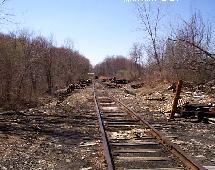...HIGH BRIDGE TO BREWSTER, NEW YORK
MENTION OF THE PUTNAM DIVISION
TO MOST ANY RAILFAN, and you will get a look of instant recognition,
followed by some remark such as, "Gee, I used to ride the right of way along Route
100 on my bike when I was a kid." There is a strong network of data on the former New
York Central line, not to mention a great reference book (by New Rochelle resident Dan
Gallo). There is much appeal for the simple single-track line that ran as a second-cousin
to the over-brimming Hudson and Harlem
Divisions. While the last passenger train turned a wheel on the Put in 1958 (and on the
upper shuttle in 1959), the Put lasted as a freight route into the 1970s. The last major
freight customer was the Stella Dorro factory in the Bronx. The only parts surviving today
are short stubs at the north and south ends which serve in various capacities as storage
tracks and turning wyes.
 ...The last passenger train on the Putnam Division was run May
1958. A shuttle train that ran from Golden's Bridge, "around-the-horn" to Lake
Mahopac, Mahopac, Tilly Foster, Carmel, and Brewster continued to run (as Harlem Division
trains) until 1959. In 1962, the middle of the Put from East View to Carmel was removed by
a private contractor. As such, parts of Route 100 were restored on the right-of-way,
especially where it parallels the Taconic Parkway. The last freight movement on the Put was
the pick-up of an empty boxcar from Creed Bros. Lumber in Yorktown Heights in 1970. An
unauthorized move occurred in 1975 when two teenagers stole a switcher from the Brewster
yards and ran it up the Put until it rammed a fallen tree at Carmel. The case was not
closed until years later.
...The last passenger train on the Putnam Division was run May
1958. A shuttle train that ran from Golden's Bridge, "around-the-horn" to Lake
Mahopac, Mahopac, Tilly Foster, Carmel, and Brewster continued to run (as Harlem Division
trains) until 1959. In 1962, the middle of the Put from East View to Carmel was removed by
a private contractor. As such, parts of Route 100 were restored on the right-of-way,
especially where it parallels the Taconic Parkway. The last freight movement on the Put was
the pick-up of an empty boxcar from Creed Bros. Lumber in Yorktown Heights in 1970. An
unauthorized move occurred in 1975 when two teenagers stole a switcher from the Brewster
yards and ran it up the Put until it rammed a fallen tree at Carmel. The case was not
closed until years later.
...The south end of the Put withered away to near nothing.
Claimed by Conrail as the Putnam Industrial Track, it served a couple of customers
in the Bronx and Yonkers until about 1980. The tracks in the Bronx were removed sometime
in the late 1980's. The track paralleling the Saw Mill Parkway were removed in sections for
use as a bike trail, although some isolated sections remain in hard-to-reach areas. Metro-North
continues to operate the last sections of the Put. The remaining trackage in Brewster is
used as a yard storage track for weekend trains.
...Some of the Put's earliest backers were approached by the
Erie Railroad in the late 1800's. The Erie already had a branch down to the Hudson River
at Newburgh for shipping coal across the river on barges. Their idea was to expand on this
idea, and to build a giant swing bridge across the Hudson, and have the Put meet the Erie
line at Garrison. That way, Erie trains could access New York directly. A hundred years
later, proposals have come from the MTA to do nearly the same thing: in the interest of
building a line to Stewart AFB Airport, one idea was to construct a new railroad tunnel at
Garrison.
...Two things killed the Put- the single-tracking of the
River Division (West Shore Railroad), and the lack of improved commuter parking
areas. Before the River Division was single tracked in 1959, the Put was used to bring
high-and-wide loads into the city. It's single track line and lack of obstructions were
perfectly suited for such a job. Odd lots were routed to Chatham, then to Put Junction,
then down the Put to High Bridge, where they would eventually end up on the West Side
Freight Line. Many of the communities that were served by the Put were rural, and did not
foresee any use for commuter parking. After the war, however, it was discovered that the
situation was inadequate. In frustration, many would-be commuters opted for the close-by
Hudson and Harlem Divisions.
...Full dieselization came to the put in 1951. Diesels from
Lima-Hamilton were used at first, later replaced by Alco RS-2 and RS-3's as well as EMD
GP7 and GP9's. Before that, the lower part of the Put was electrified with third-rail by
1920. Oddly enough, the electric MU trains operated on the Put did not run into Grand
Central. Through the end, passengers continued to make the odd across-the-platform
transfer to Hudson Division trains at High Bridge. Gas-electrics also made their
appearances on the Put in the 1930's and 1940's. One can wonder why the Central didn't
assign some of its 19-car Beeliner RDC fleet to Put service, which would have been
perfect for this type of service.
...These days, there is much talk of expanding highways and
airports, making private busways, and investigating new routes into New York City. Are
"new" railroads out of the question? It is unfortunate that one such line now
only survives as a bike trail.
| GCT | NYW&B | End-of-Track |
Home
|
Please mail your comments to:
![]()
Last updated
November 10, 2010
